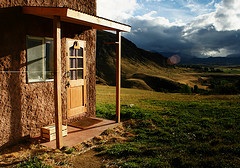RIDING THE GEO-THERMALS AT NOLS PATAGONIA

When exploring sustainability initiatives at NOLS Patagonia, the deeper you dig, the richer things get. On the surface, strawbale-constructed instructor housing overlooks a working farm. Chicken, geese, cows and sheep roam the 500 acres, producing eggs, meat, and the essentials for a traditional asado, or lamb roast, that follows every NOLS semester. These animals, along with homemade compost, provide nutrients for the large garden and greenhouse that grow potatoes, peas, carrots, garlic, and other delicious vegetables that feed staff, students, and the community. Water for the garden, and for the entire facility, comes from natural mountain springs that flow into a gravity-fed system. The branch is in the process of doubling the size of the greenhouse and the garden. Excess produce will be sold at the local market
Keep digging down and you find more surprises. The recent completion of a geo-thermal heating system has cut the budget by almost $1,000 a month, which was previously spent entirely on propane. Just five feet underground, the ambient temperature of the earth warms fluid to 50 degrees Fahrenheit as it runs through a series of coils. This collected heat energy is extracted by a heat pump, which heats a second fluid system, channeling warm water under the floors and heating the entire facility through radiant heat from the ground up. Contrary to popular thought, no deep wells were dug, and no magma is involved.
To see a profile of NOLS Patagonia, visit: http://www.nols.edu/courses/locations/patagonia/about_patagonia.shtml
photo courtesy of Rich Brame
Topics: Environment
